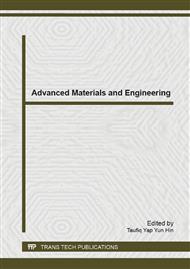[1]
S. Murata and M. Stojanovic, DNA-based nanosystems, New Gener. Comput. 26 (2008) 297-312.
DOI: 10.1007/s00354-008-0047-7
Google Scholar
[2]
N. Seeman, Nanotechnology and the double helix, Sci. Am. 290 (2004) 64-75.
Google Scholar
[3]
P. Yin, A. Turberfield, S. Sahu and J. Reif, Design of an autonomous DNA nanomechanical device capable of universal computation and universal translational motion, LNCS 3384 (2005) 426-444.
DOI: 10.1007/11493785_37
Google Scholar
[4]
N. Brener, F. Ben Amar and P. Bidaud, Characterization of lattice modular robots by discrete displacement groups, in: IROS 2010, 1133-1139.
DOI: 10.1109/iros.2010.5649934
Google Scholar
[5]
T. Fukuda and S. Nakagawa, A dynamically reconfigurable robotic system (Concept of a system and optimal configurations), in: Proc. of the 1987 IEEE Int. Conf. on Industrial Electronics, Control, and Instrumentation, 1987, 588-595.
DOI: 10.1117/12.943013
Google Scholar
[6]
M. Yim, W. Shen, B. Salemi, D. Rus, M. Moll, H. Lipson, E. Klavins, and G. Chirikjian, Modular self-reconfigurable robot systems: challenges and opportunities for the future, IEEE Robotics & Automation Magazine 14 (2007) 43-52.
DOI: 10.1109/mra.2007.339623
Google Scholar
[7]
S. Murata and H. Kurokawa, Self-reconfigurable robot: shape-changing cellular robots can exceed conventional robot flexibility, IEEE Robotics & Automation Magazine 14 (2007) 71-78.
DOI: 10.1109/mra.2007.339607
Google Scholar
[8]
F. Hou and W. Shen, On the complexity of optimal reconfiguration planning for modular reconfigurable robots, in: ICRA 2010, 2791-2796.
Google Scholar
[9]
A. Gorbenko and V. Popov, Programming for modular reconfigurable robots, Programming and Computer Software 38 (2012) 13-23.
DOI: 10.1134/s0361768812010033
Google Scholar
[10]
A. Gorbenko and V. Popov, Self-learning of robots and the model of Hamiltonian path with fixed number of color repetitions for systems of scenarios creation, Advanced Materials Research 683 (2013) 909-912.
DOI: 10.4028/www.scientific.net/amr.683.909
Google Scholar
[11]
A. Gorbenko and V. Popov, The set of parameterized k-covers problem, Theoretical Computer Science 423 (2012) 19-24.
DOI: 10.1016/j.tcs.2011.12.052
Google Scholar
[12]
V. Popov, Multiple genome rearrangement by swaps and by element duplications, Theoretical Computer Science 385 (2007) 115-126.
DOI: 10.1016/j.tcs.2007.05.029
Google Scholar
[13]
V. Popov, Computational complexity of problems related to DNA sequencing by hybridization, Doklady Mathematics 72 (2005) 642-644.
Google Scholar
[14]
V. Popov, The approximate period problem for DNA alphabet, Theoretical Computer Science 304 (2003) 443-447.
DOI: 10.1016/s0304-3975(03)00211-1
Google Scholar
[15]
W.M. Spears, D.F. Spears, J. Hamann and R. Heil, Distributed, physics-based control of swarms of vehicles, Auton. Robot. 17 (2004), 137-162.
DOI: 10.1023/b:auro.0000033970.96785.f2
Google Scholar
[16]
L. Xie and J. Zeng, The performance analysis of artificial physics optimization algorithm driven by different virtual forces, ICIC Express Lett. 4 (2010) 239-244.
Google Scholar
[17]
Y. -J. Wang and C. -T. Lin, Runge Kutta neural network for identification of continuous systems, in: ICSMC 1998, 3277-3282.
Google Scholar
[18]
P. Rothemund, Folding DNA to create nanoscale shapes and patterns, Nature 440 (2006) 297-302.
DOI: 10.1038/nature04586
Google Scholar
[19]
Genomes Pages - Eukaryota. Information on http: /www. ebi. ac. uk/genomes/eukaryota. html.
Google Scholar


